KressJetsTM Today
By Ken Myers
I recently received an email from John Kress announcing an update to the Kress Jets EDF units and a new plane added to the KressJetsTM line of kits, semi-kits and plans. Many of you may not be familiar with KressJetsTM, so here is a little company history as posted on their Web site.
"KressJetsTM has been producing ducted fans for gas engines since 1975. Most are still in production. Our ducted fan kits were also produced by Midwest and Kyosho (Axiflow & AeroJet Fans).
The founder of Kress Jets and Kress Technology, Robert Kress has been in the aviation business for over 50 years. Working at Grumman Aerospace Corporation he was a designer and design manager for such projects as the Lunar Lander (Navigation and Control) and the F-14 Tomcat. His role in the "F-14" can be seen on the History Channels "Modern Marvels" TV broadcasts and DVD. He was called back to Grumman in the early 1990s to serve as VP of Advanced Concepts. He is now retired and lives in upstate New York. His work over many years on ducted fans development for models is published here in his notes - 'Ducted Fan Theory'.
Kress Technology Inc. is now owned and operated by John Kress with Robert Kress as director, adding new products and inventions to the KressJets™ product line. John Kress' expertise is in Internet development and marketing."
The newest fan unit from KressJetsTM is the RK-709E AXI-FAN. This unit, with AXI 2212/20 motor, weighs in at just 5.8 oz. and delivers 17.3 oz. of thrust while pulling 11.8 amps with 15.3 volts being supplied to the motor. Here is how it is describe on the Web site.
"At Kress Jets we have been testing with the AXI 2212/20 outrunner motor in our RK-709E electric ducted fan. The characteristics of this motor are a perfect match for our 7 blade rotors, which run best under high torque and high disk loading. This results in fans that have more static thrust for a given diameter and high-end power for faster models.
Results for the RK-709E are similar for our complete line of Electric Ducted Fans. We will be adding new Motor/Fan combinations and conversion kits for our RK-720E and RK-20E in February 2005."

Photo of unit from KressJetsTM Web site - http://kress-jets.com
Specs from Web site for Out-Runner AXI 2212/20:
Wt; oz.: 5.8
Rotor: 7B RK-709E
Thrust; oz.: 17.3
RPM/1,000: 16.3
Motor Wt; oz.: 2.0
Volts/AMPS: 15.3/11.8
Max Allowable Amps: 16.0
Diameter; in.: 1.09
Motor Centerbody ID: 1.25
The plane for this upgraded power system is the New KressJetsTM F-4 Phantom.

1/20 Scale F-4 Phantom Completed Structure. 9.2 oz.
KressJetsTM Web site photo
Specs for the F-4 from the Web site:
General:
Wing Span: 24 in.
Wing Area: 219 sq.in. 1.52 sq.ft.
Flying Weight: 22.5 oz.
Wing Loading: 14.8 oz./sq.ft.
Wing Aspect Ratio 2.61:1
RK-709E 3 in. AXI-FAN
Static Thrust: 17.3 oz.
Fan Weight: 5.5 oz.
Thrust/Weight Ratio: 0.77:1
Weights:
Structure: 9.2 oz.
AXI-FAN: 5.5 oz.
JETI 18-3 Controller: 0.8 oz.
Rx FMA Quantum 6: 0.5 oz.
(2) Futaba FP-S133 Servos: 1.3 oz.
(2) Thunder Cells; 14.8 V @ 860mAh: 3.0 oz.
Finish Allowance Some Light Silk Span & Dope: 2.2 oz.
Total: 22.5 oz.
That is one of the most complete specifications I've ever seen anywhere.
Congratulations to KressJetsTM for providing the information we need to make an informed decision about their product!
Other KressJetsTM kits, semi-kits, plans and patterns available include:
Grumman A-6E Intruder
V-1 Buzz Bomb
A-10 Thunderbolt
P-38 Lightning
There are other kits and fan units as well, so check the Web site at kress-jets.com.
Obviously, the P-38 is not a jet, but a very unique design that incorporates a single motor driving both props. One of our EFO members built and flew one of these in the early 90's. With today's brushless motors and Li-Po cells, this could be an outstanding way to build a twin without having to have two separate speed controllers for two brushless motors. If anyone decides to give this project the brushless Li-Po update, I'd be very interested in printing your experiences here in the Ampeer.
The P-38 is offered as a semi-kit. Here are the specs from the Web site:
P-38 Lightning Specification
Span: 48"
Wing Area: 305 sq.in.
Wing Loading: 25.5 oz./ft.
Length: 35.84"
Weight: 54 oz. (I bet it can be a lot lighter today! KM)
Special Features: Optional P-38 Twin Engine Drive Kit
Control Functions: Aileron, Elevator & Throttle
Return to "What's In This Issue?"
Different Motor for the HL Mini Telemaster
From Joe Morgan j_morgan@mindspring.com
Ken,
I don't know if you have the time and/or inclination to respond to this message, if not just let me say thanks for your website ...I have enjoyed it for at least the last two or three years.
(I respond to all the emails I receive. Thanks for your kind words Joe. KM)
I currently have a project in progress, a mini Telemaster, that I would like a suggestion or confirmation on. Rather than the motors suggested (Uberall "Nippy Black" 1208/180 External Rotor Brushless according to the HL site. KM) I am thinking of using an AXI 2212/20 with probably a Jeti controller.
Obviously I am not interested in an aerobatic airplane otherwise I would have made another choice...but I do want a strong performance with a short takeoff run and steep climb ability. Perhaps occasionally a short burst of vertical flight. My main question is would this particular motor be strong enough to provide that kind of performance or would I need to choose a more powerful one? I would lean toward more powerful motors so they could be used in the future for larger craft. This particular model is dimensionally and weight wise similar to the Cutie. If I were to use a larger than required ESC would there be any penalty other than the weight and cost?
The first thing I did to try and answer some of your questions was to get the info to make an informed recommendation. I read the review of the Mini Telemaster at the Ezone Magazine (www.ezonemag.com). The reviewer used the recommended Nippy motor and noted that it had plenty of power when used with an 8-cell pack. I also read the review of the Nippy Speed 400 on the Ezone Magazine site and found the following statement, "Nippy 400 8-cell 600AE, 8x5 prop 13.5 amps static". I saw that the HL recommended prop for the Nippy is the APC 8x6 SF. Also using an 8-cell pack, the reviewer of the Mini Telemaster noted, "With the recommended 8x6sf APC prop, the motor was pulling 14a and about 120 watts."
Next I went the Model Motors site (http://www.modelmotors.cz) and found the following data for the AXI 2212/20.
Prop: 8x4.5 Gr. CAM fold.prop
Battery: 8x RC2/3SC
Amps: 9.6
RPM: 9640
Volts: 9.1
Prop: 8.5x6 Aer Glas
Battery: 8x RC2/3SC
Amps: 12.2
RPM: 8840
Volts: 8.9
Prop: 9x5 Gr. CAM fold.prop
Battery: 8x RC2/3SC
Amps: 12.5
RPM: 8740
Volts: 8.8
The Nippy 400 review from the Ezone gave the following data:
Watts: 125
Volts: 8.4
Load RPM: 8,640
Prop Size: 8 x 6
Amps: 15
The "Nippy Black" 1208/180 weighs about 61g and the AXI 2212/20 about 57g, so weight is fairly even. The numbers, if looked at carefully, show that the AXI has a slight edge, since it can turn a 9x5 at a higher RPM and lower current than the Nippy with an 8x6, indicating a more efficient motor.
I chose to compare them with 8-cell packs, since the data was not available for comparison with 7-cell packs. A 7-cell pack should fly the Mini Telemaster just fine with either of these motors, and an 8-cell pack should provide lively performance.
Both of these systems would be fine in the SR Batteries Cutie, although for the "fun of it" I just might use a 3-cell Li-Poly and a prop that would pull about 15 or 16 amps.
On this size plane, a larger ESC would not be a great penalty. I have always planned on pulling out an ESC and using it with another project. Note that I said planned. It has never happened in more than a decade! The 18-amp Jeti should be just fine, if that is what you want to use.
I have been building and flying models for many, many years and I have NOT been able to correlate the abundance of information about the electrics to a usable knowledge for myself-yet. I began to "play" with the electrics two or three years ago but at my stage of life knowledge accumulates and adheres very slowly. Do you have a suggestion for publications that would help me to understand the nomenclature about motors?
There are none! The best way to compare motors is the way I just showed you by gathering the above data. If you can't find the data, my recommendation would be to go with the brands that do provide the data you need to make an informed decision.
The number of turns, timing and RPM/V don't really speak to me at this time.
You are not alone!
Since the park flyers and small electrics have gotten so popular the number of motors available has literally exploded ... and I really need to build my knowledge to be able to partake of this availability. It goes without saying that I don't have an unlimited treasure chest to explore with; otherwise I would just buy and experiment.
As my flying buddy Keith Shaw, has said over and over, "Buy cheap, buy twice." See my article about the AMMO motors in the Feb. '05 Ampeer.
Thanks for anything you can provide and thanks again for a very informative Web site.
Joe Morgan
It is my pleasure Joe, and I hope that I've helped you out some.
Return to "What's In This Issue?"
Alpha Models F4U-1 CORSAIR
From Mike Southwood michael.southwood@ntlworld.com
Hi Ken,
As a 71-year-old model plane fanatic, I thought you might be interested in my review of the Alfa Models Corsair. It is possibly the best electric powered model I have ever flown. I don't know why it performs so well, but with an all up weight of just 12 oz, it only needs the standard Graupner 300 motor to go vertical and fly for 15 minutes on an 800mah Li-Poly 11.1v.
The review has gone on our club website: www.hmfc.co.uk, but you are welcome to use all or part.
I started flying electric models many years ago and soon realised that the power weight ratio was poor. Many of my first attempts being too heavy and underpowered. My first success was an EasyStreet built from a kit by Balsacraft (now gone). Fitted with a Jeti Phasor brushless it flew quite well, but very fast and tip stalled very easily. I still fly one, but this one is an ARTF by Ripmax. Looks good, but is even heavier. I thought it was good until I launched the Alpha Corsair. Now I am convinced that electric is a viable proposition. For a small plane it behaves just like a 40 glow. I cannot be bothered to fly the EasyStreet any more, despite fitting a Li-Poly pack, cutting the weight by 8oz.
Regards,
Mike Southwood
Hemel Hempstead Model Flying Club
UK.
ALFA MODEL 0208
Made in Czech Republic
A Review by Mike Southwood
The plane is an electric semi-scale model, moulded from a tough foam plastic with a hard skin. Detailed with panel lines, rivets etc and decorated with waterslide transfers. It comes complete except for servos, radio, propeller and battery. There are only two parts and nothing to glue together.
32" wingspan. 25" long. No undercarriage, so always a hand launch and belly landing.
All up weight of my completed plane, ready to fly is 12 oz (345g) Max allowed is 420g, so it has come out very light.
Motor is supplied fitted to a gearbox. A 380 Graupner can motor.
I chose an 8x6 Graupner Cam Slim Prop. Not mentioned in the instructions.
Speed controller is a Ripmax 22 amp. Could use a smaller version if too heavy.
Radio used is Jeti Rex4 plus. Very light at 10g with standard crystal.
The power supply is an 800mAh, Li-Poly weighing just 60g (2oz in English) This is too powerful at 11.1 volt, but by using the throttle it should not melt the motor for a while.
Unpacking from the large box, the fuselage and tail section are fully assembled. Very light but quite rigid. One has to be careful. I know because I cracked off one tail part in the shop (not this one I am pleased to say) At least this showed me that ordinary super glue works if required.
The motor and gearbox are assembled and packed in a plastic bag. All one does with these parts is screw them to the bulkhead after soldering the electronic speed controller and suppressors to the motor. The thin plastic cowling is a push fit to the front and has a dummy engine filling the hole. This may need a few holes cut in it to cool the motor.
No rudder, so only two lightweight servos are required. In my case I used a pair of Saturn 6.2g servos. Fitting the strongest, longest arm supplied with the kit connectors. The operating wires are very thin; two can be passed through the plastic tube supplied and then through the servo connector, allowing easy setting of the ailerons. These are shown set 1 mm higher than the wing section. The servos were held in place by epoxy. I cut off the mounting tabs to make the aileron servo fit better. The aileron wires were bent to give a more direct entry to the servo connector. The instructions also suggest that the wires are removed from their outer guide tubes and lubricated with WD 40.
Fixing the battery in is easy if one uses the Li-Poly route. Velcro tape is supplied.
I cut a small hole in the fuselage side to feed through the ESC on/off switch, then epoxied this in.
The fuselage has a nice big hatch on top allowing fitting of servo, radio and battery. It has a nice little sliding catch.
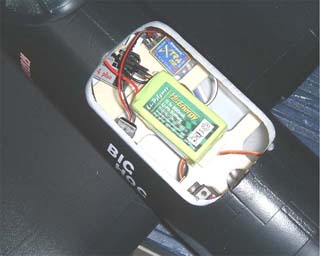
The photo shows the hatch cover removed showing the 800mah battery pack, Ripmax 22 amp speed controller and the Jeti FM4 REX4 receiver. Not yet fixed.
The elevator servo can just be seen at the front right.
There is plenty of room if the Li-Poly is used.
A very nice set of waterslide transfers are supplied. Care has to be taken as they are very thin and need to be placed
before sliding out the backing. The original paint finish is excellent and the moulded in detail very good. No location plan is given and the transfers did not match the box artwork, but wherever you put them, they look good.
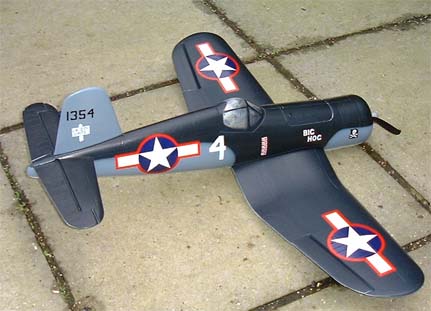
My mistake was to put an insignia on both wings, one should have gone underneath.
The numbers and insignia for the fuselage are too large to fit on the fuselage, so only one of the four supplied was fitted.
The canopy is pre fitted without a pilot. A plastic unpainted pilot is included but I did not risk prying off the canopy to fit it!
Having finalised the build, I made a few changes. The ESC motor wires were rather long, so I cut them to 1" and soldered them directly to the motor. The input end I soldered on 2.5mm tubular gold plated tubular connectors. The same with the battery pack, but male to female matched. I also made up a charger lead using the same connectors.
The radio was stuck to the fuselage floor just behind the battery platform. The supplied Velcro attached the battery. First having thinly coated the ply platform with UHU.
Balance came out exactly as called for on the plan, with useful marks on the underside being moulded in.
The first flight was using an 8x6 propeller. Checked amps were 9 on the ground. Good enough. Later I will try a 9x6 Slowfly prop.
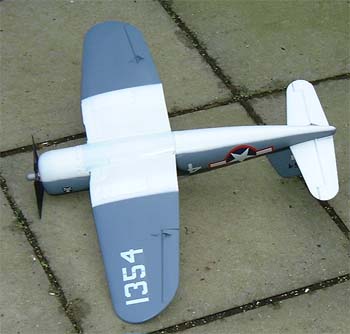
Ground tests showed that at full throttle, the power was enough to lift the full weight of the model.
The radio worked very well with no glitches, despite the short aerial wire and standard brushed motor.
It always felt as if it wanted to fly!
My charger is a special Li-Poly unit from JP. It is a bargain at about £16. Fully automatic and so far has worked well.
No excuses, let's fly!
FLYING:
Our usual Saturday morning turned out to be fine and dry. There was lovely blue sky and almost no wind. We went to the Shenley site at about 11.30 am. It was a super morning for flying, although it was very cold at just above freezing.
First I flew my EasyStreet, just to get in the practice. No problems, about 15 minutes on its 3 cell Li-Po.
Then having checked the direction of controls etc, pal Derek gave the little Corsair a gentle launch into the sky. I had set the rates at 50%, which proved to be only just enough to allow me to straighten up from the launch, but with rates switched out it was soon in trim. A little right and a little up, she was flying perfectly. Not easy to set the controls perfectly on the ground as they are quite springy.
Flying proved to be a doddle. Easy and extremely stable, despite its small size and very light weight. I was soon doing loops and rolls. Loops were perfect, rolls a bit rough, but with the safe wing section and no rudder this was expected. Motor power was plenty. After take off, most of the flight was at 50 percent or less. Full power was only used for vertical climbs. Shut right down, it proved difficult to stall, full up elevator just caused it to mush, never dropping a wing.
Within minutes I was making low passes, both at full speed and very slow. There was never a glitch from the radio.
We timed the flight and at 14 minutes, hands were getting cold, so a landing called. No problem, so stable and slowed up to walking pace before gently sliding onto the patch.
A check showed that the Li-Poly 800mah was still showing 11.4 volts and still capable of turning the prop at full power. The pack was also almost cold. I did not have my charger; so one flight was all I had planned. But when another member turned up and asked to see it fly, we chucked it up again and did a few circuits for about 3 minutes before it showed signs of slowing and was landed.
CONCLUSION:
It is a superb small model, not cheap if you have to pay full price and buy all the super light bits.
Model: £94.99 from Slough Radio Control Models
Radio: £25.50 Al's Hobbies
Servos: 2 x HS 81's £12.95
ESC: Jes 012 £25.50
Prop: 9 x 6 Slow Fly £5.00
Li-Poly: 800mAh £25 -30 Depending where!
Charger: JP or your choice. £16 or more
Has to be seen to believed! Can't wait to get the FW 190 or Mig15 EDF.
Return to "What's In This Issue?"
Lithium Sulfur Cells on the Horizon?
From Jon McVay Togflier@aol.com
Jon sent a brief email with the following URL www.sionpower.com/pages/sion_technologysummary.php
It leads to a site for Sion Power, which appears to be developing Lithium Sulfur cells, which they have trademarked as Li-STM. There is a lot of literature there, but no announcement about production. The thing that I found most interesting is that the cells are rated at 2.1 volts. It would be somewhat easier to make even cell combinations with 2.1v per cell than the 3.7v per cell of Li-Po cells.
Thought you might find this interesting, if not exactly useful at this point. It does have implications for us, as the cells use with power tools and automobiles is mentioned.
Return to "What's In This Issue?"
Push-E Cat is Back
From Dave Stacer (EFO member) dstacer@dsemail.com
As I had announced earlier, Darwin Garrison had told us that the Push-E cat would be back. Dave sent an email with a pointer to a thread on the RCGroups discussion site. This is what Darwin had to say about the return of the Push-E Cat.
"Hello, Folks:
Well, after a long and oddly twisted path, I can safely let you all know that I have reached an agreement with Denny Maize of Polecat Aeroplane Works (www.polecataero.com) to continue production of the Push-E Cat, version 4.
Kits will be available from Denny starting no later than March 1, 2005. He's already got the CNC set up to cut wings and fuselages and I am finishing up the new addendum for the V4 instructions.
The new V4 Push-E Cat features a revised wing planform that improves turning performance. The addendum instructions will include hints for "streamlining" your 'Cat and adding lightweight tailfeathers. With the advances in Li-Poly and Outrunner motors, it is possible to build a totally thermal capable Push-E Cat without compromising structural integrity.
Denny will also be producing our aileron version of the Push-E Cat, the Twin Cat, sometime later this year.
Denny is finalizing his price structure at this time. Please visit his website and contact him for additional information as it becomes available.
Best regards,
Darwin Garrison"
Return to "What's In This Issue?"
Greg Gimlick New Electric Columnist for MA
Hi Ken,
I hope all is well in your world. Things are busy here as we build our retirement house and things change in my magazine world. I'll just give you a copy of the "release" instead of re-typing it all...as you can see I'm lazy :-)
Feel free to let anyone know of the change. Since I once again have editorial control over what I write (a welcome relief) I'll once again be referencing your newsletter if that's okay. Here's the "official note":
I wanted to let you know of the latest events in my electric world. As you know, I've been writing the "Powerlines" column for Model Airplane News for the last couple of years. This last year they decided to begin phasing out columns and moving to an all "feature format" and I will continue to do articles and reviews for them as time permits.
As you are no doubt aware, Bob Kopski has written the electric flight column for AMA's Model Aviation magazine for many years. Some of his original articles are what got me into electrics and am grateful for his contributions. Bob has decided to retire and Model Aviation magazine has asked me to step in and take over the column. As a long time supporter of the AMA, I was more than happy to accept and find a home for my column again. I am looking forward to many years there.
Aeromodeling Editor Bob Hunt and I have discussed the direction of the column and are very excited about the future. My column will be published every other month alternating with Red Scholefield's column on batteries and charging. This will keep the format fresh and I will concentrate on everything from the battery connector forward along with the model itself.
I have been given "carte blanc" to cover everything related to electric models.
Some columns will be lessons on various aspects of electric modeling; others will be full reviews of products, while others will be new product introductions. Reader input will be encouraged along with that from manufacturers and vendors.
I welcome your input and critique as always. I hope to emphasize the good things in our hobby and promote it to the best of my ability. I hope I can continue to enjoy your friendship and support as in years past.
Take care,
Greg
If Bob has to "retire", I'm glad that it is Greg stepping in. What a great choice. Mr. Kopski has been an inspiration to me for all of these years, and I will certainly miss reading his informative and useful column every month. Best wishes to both Bob and Greg from the EFO!
Return to "What's In This Issue?"
February EFO Meeting
As mentioned last month, the February EFO meeting was held at Rick Sawacki's house in Commerce, MI. The meeting was well attended.

Roger Wilfong shared his newly designed and purpose built electric flight field box. For ease of portability, it comes apart in sections and can easily be set up for field use.
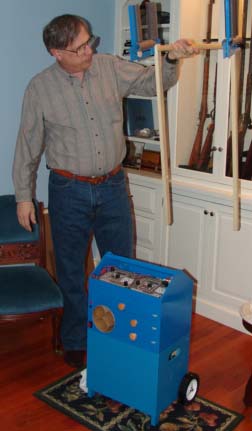
Tim shared his EasyStar and Micro Flyer. Rick is teaching Tim to fly the EasyStar, which is an excellent trainer. Tim has taught himself to fly the Micro Flyers and fielded many questions about it.
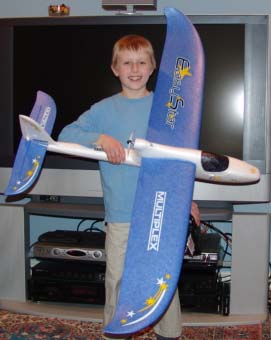
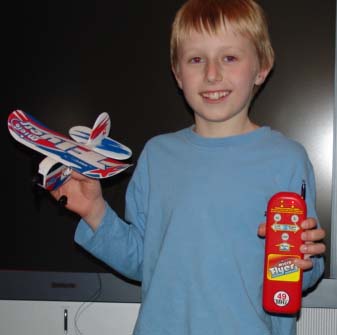
It was a wonderful evening of plane discussions and fun topped off with a trip to Rick's dungeon, where years of model planes and racing boats are stored. What great memories lie there! Thanks Rick for being a great host.
The April EFO meeting will be a flying meeting on Saturday, April 16 at Lyon Oaks Park in Wixom, MI. The park is located on Pontiac Trail about 1 mile west of Wixom Rd. Entry to the park is free that day. MISS is sponsoring this event. All E-flyers are welcome. AMA required to fly. See you there at 9:00 a.m.
Return to "What's In This Issue?"
Combat with Pico Tiger Moths
From: Dave Behner dave_behner@hotmail.com
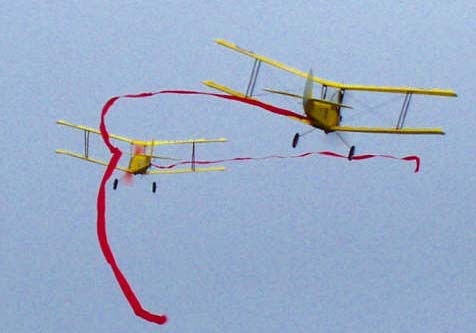
Hi Ken,
The weather in Portland, Oregon has been unusually mild this year allowing us to spend a lot of time in the air. My friend Spencer Poff and I have Pico Tiger Moths and have started flying combat. See enclosed pictures. We have been using cut down Crape paper (3/4" by 20 feet) and were wondering if there is anything better to use? Sometimes it get tangled in the prop.
Thanks so much for your efforts on such a GREAT newsletter every month!
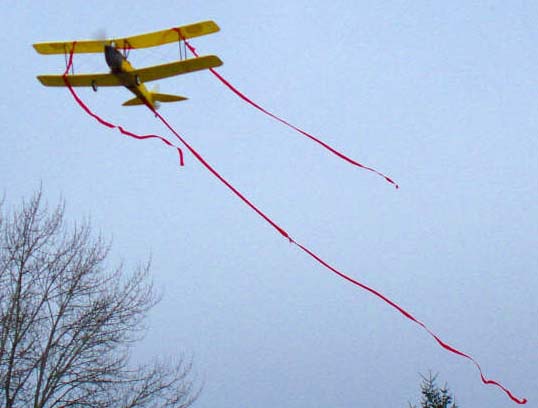
Thanks for the kind comments about the Ampeer. Much appreciated. Hopefully some Ampeer readers might have an idea about what to use instead of crape paper. KM
Return to "What's In This Issue?"
Upcoming Skymasters Electric Flight Forum
Okay, so you missed the Plymouth Pilgrim Electric Power Technical Session held on October 28, 1984. You don't have to miss this one, 20 years later!!!
The Skymasters are inviting all those interested in electrically powered models to attend their Wednesday, April 27 meeting. The meeting starts at 7:30 P.M. at Larson Middle School, 2222 E. Long Lake Road, Troy, MI. The scheduled speakers include Ken Myers, Keith Shaw, Jim Young, Jack Lemon, and others in a panel discussion of all things electric. These are some of the nations leading authors, experts, and innovators. The projects that they will bring are worth your visit. The knowledge they will share is priceless!
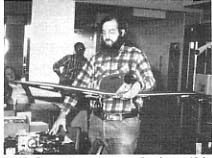 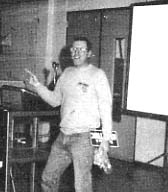
Keith Shaw w/Spitfire (left) & Ken Myers (right) at the 1984 Plymouth Pilgrim Electric Power Technical Session. Photos by Tim Bissell via May 1985 RCM magazine.
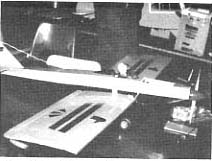
Ken's 1984 AF 40 direct drive Spickler Q500.
Tim Bissell photo
Return to "What's In This Issue?"
| 














